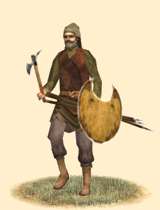Tabargânê Êrânshahr (Eastern Axemen)
 |
Weapons | Defence | Mental | ||||||
|---|---|---|---|---|---|---|---|---|---|
| Primary | Secondary | Armour: | 2 | Morale: | 10 | ||||
| Type: | spear | axe | Shield: | 2 | Discipline: | impetuous | |||
| Attack: | 6 | 8 | Skill: | 11 | Training: | untrained | |||
| Charge: | 6 | 6 | Recruitment | Other | |||||
| Lethality: | 1 | 0.165 | Soldiers: | 50 | Hit Points: | 1 | |||
| Range: | 60.5 | 0 | Cost: | 1454 | Mass: | 1.05 | |||
| Ammo: | 4 | 0 | Upkeep: | 364 | |||||
| Turns: | 1 | ||||||||

The Tabargân are lightly equipped assault infantry armed with the Sagaris, meant to be used as a surprise element. They are useful in ambushes and raids and will prove useful to anyone who can use them properly.
Hardy
Sapping Ability
The Tabargân are steadfast warriors, aggressive and impetuous in temperament, valued by Iranians and Hellenes alike for their ferociousness and courage. These hillmen are recruited as irregulars from the mountains of Iran, not least from the Zagros and Elburz ranges, areas that breed toughness and have done so for centuries. Though certainly not as disciplined as Hellenic heavy infantry, nor even comparably attired, they are armed with the Sagaris, or the "Persian pick-axe" (Ironically being Scythian in origin) which they wielded with skill, and a bundle of javelins, and they are prepared for guerilla warfare tactics such as ambushes and surprise attacks; they are particularly fond of broken terrain where disciplined troops accustomed to fighting in formation would fare badly. This is facilitated by their light attire, as they bear no armour and the only true means of protection is a light shield, nimble movement and dauntless impetus, casting themselves into the fray. Distinguished by traditional Iranian highlander garb such as the Kyrbasia cap, baggy trousers, a woolen tunic, boots and a thick sheep-skin jerkin, these tough hillmen could almost be mistaken for shepherds or nomadic herders.
However, these hardy hillmen are nothing to scoff at, as the pick-axe could puncture helmets, and penetrate bronze and iron armour. The Tabargân were no less skilled with their javelins, in which the usage of javelin-thongs increased the stopping power and accuracy of the javelin, giving it a spin during flight. Using them properly, they will give a good account of themselves. Using them poorly on the other hand may prove suicidal and their dauntless bravery may quickly turn into fragile bravado.
Historically, the northern Iranian highlands are known for their hardy mountaineers who held all transgressors at bay. These men of the mountains were lightly ruled by all Persian Grandees who valued their warrior skills over what meagre income their mountain homes might bring. These men would be recruited from the warlike Gîlânî and Dailamî tribesmen of Verkhânâ (Hyrcania), and other similar peoples of northern Media. The earliest origins of these people are unknown, although the Dailamites could be the descendants of such ancient peoples as the Delumïoi (Delumioi) and Karduchoi (Kadousioi or the Cadusians) mentioned by Ptolemy in 2 AD. Classical historians mention Dailamites, 'Dolomites' or other very similar names repeatedly and their name is particularly mentioned in context with the later Byzantine Varangian Guard. Due to the mingling of migrant tribes with the indigenous residents of the region, several new clans were formed, of which, the two tribes of 'Gill' and 'Daylam' formed a majority. In the 6th century BC, the inhabitants of Gîlân allied with Kûroush (Cyrus) the Great and overthrew the Medes helping to establish the Achaemenid Persian Empire. The Dailamites would later during the Sassanid dynasty form a core of heavy infantry with fine equipment including brightly painted shields and two-pronged javelins, meant to be pitted against the finest Roman infantry.
However, that is a long way from the continuously more declining irregular force, the Takâbarâ as they were called by the Achaemenids, and in Parthian history, the Tabargân are merely the residue of the Iranian highlander spirit, not exclusive to the Elburz range but to all areas of Iran where the environment breeded toughness